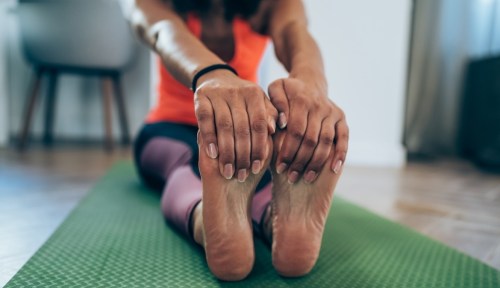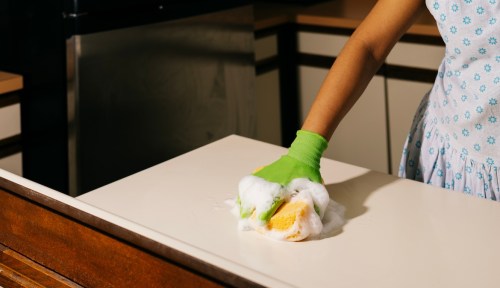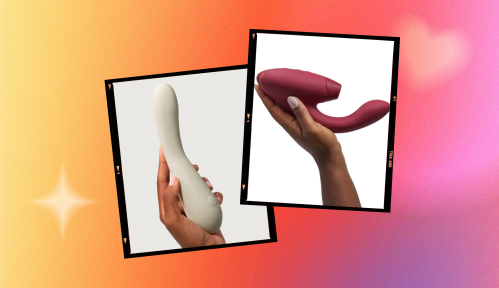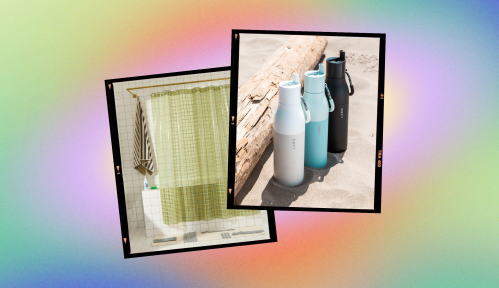Few things are more frustrating than a nagging, deep itch on the bottom of your foot. Maybe the itchy, tingling sensation kicks up while you’re walking for long periods of time, while wearing tight socks, or as you’re drifting off to sleep at night. Usually, the cause of prickly feet is easy to pin down (and treat), but sometimes, it may be a sign of an underlying health condition.
Experts in This Article
board-certified dermatologist
Here, we spoke with Lauren Ploch, MD, MEd, a board-certified dermatologist in Georgia, to learn what causes that deep itch on the bottoms of your feet, and how to get relief—with natural remedies and doctor-approved meds.
10 causes of a deep itch on the bottom of your feet
1. Dry skin
Sometimes itchy feet are just from dry skin. It is one of the most common places to get dry skin, after all, per the Cleveland Clinic. When your skin lacks moisture, it can become scratchy. Other telltale signs include the following, per the Cleveland Clinic:
- Rough patches of skin
- Skin that’s scaly or flakes easily
- Skin that cracks and/or bleeds
- Skin that’s lighter or darker than your normal skin tone, or red to purple
- Tight skin
How to treat it:
Moisturize, moisturize, moisturize. It will safeguard your skin’s barrier, keeping it soft and supple. Look for products with emollients (which soothe and hydrate the skin) and hyaluronic acid (which increases moisture in the skin), according to the Cleveland Clinic.
2. Athlete’s foot
Your itchy feet could be caused by fungi (unfortunate, but true). Athlete’s foot—also called tinea pedis—is a fungal infection that triggers an itchy, scaly rash. You can catch it by touching someone who has it, or by touching their belongings—like their socks, towels, or shoes. The fungus can also spread from your feet to other parts of your body.
Other symptoms of athlete’s foot may include the following, according to the Mayo Clinic:
- Scaly, peeling, or cracked skin between the toes
- Inflamed skin that might appear reddish, purplish, or grayish, depending on your skin color
- Burning or stinging
- Blisters
- Dry, scaly skin on the bottom of the foot that extends up the side
How to treat it:
Because athlete’s foot is contagious, you’ll want to nip it in the bud fast. Your dermatologist can treat it with an antifungal medication, says Dr. Ploch. There are some effective over-the-counter products for treatment available, notes the Cleveland Clinic. Just be sure to follow all the instructions carefully.
To avoid athlete’s foot in the future, keep your feet dry and cool. Fungi flourish in warm, humid conditions (like damp socks and tight-fitting shoes). Here are few tried-and-true tips to prevent tinea pedis, per the Mayo Clinic:
- Let your feet air out: Wear sandals when you can, and opt for breathable shoes.
- Wash your feet daily: Use warm, soapy water and rinse and dry your feet thoroughly, especially between the toes. Don’t forget to pat your feet dry after you bathe.
- Apply a medicated foot powder: if you’re prone to athlete’s foot.
- Change your socks at least once a day: And switch out of sweaty socks ASAP.
- Select moisture-wicking socks: If you’re prone to sweaty feet, fabrics like cotton wick moisture to help keep them dry.
- Use different shoes from day to day: This gives your shoes time to dry after each use. You can also invest in a couple pairs of breathable, lightweight running shoes to rotate.
- Protect your feet in public places: Wear waterproof sandals or shoes around public pools, showers, and locker rooms.
3. Other skin infections
Other types of skin infections can lead to itchy feet, too. One of the most common? A bacterial skin infection called impetigo—which causes itchy sores and blisters. It typically happens when bacteria enter broken skin (like a cut, bite, or scratch), though you can become infected even if your skin isn’t broken or punctured, according to the Cleveland Clinic.
Along with itchiness, other signs of impetigo may involve the following, per the Cleveland Clinic:
- Pus-filled blisters that burst easily
- A rash that causes red, raw skin
- Skin lesions
- Raw, shiny areas of skin that scab over with a yellowish-brown crust
- Swollen lymph nodes
Impetigo usually affects children (and forms around the mouth area) but adults can get it, too (and on any body part, including the feet), per the Cleveland Clinic. And like athlete’s foot, impetigo is highly contagious. You can catch it through contact with an infected person or contaminated surfaces.
How to treat it:
To stop the spread of impetigo, go to your doctor ASAP. They’ll prescribe a topical antibiotic (or an oral one, depending on the severity of the rash). You should see an improvement in your symptoms within a couple days of taking the medication.
4. Intrahepatic cholestasis of pregnancy
Itchy feet? If you’re pregnant, you can chalk it up to another strange symptom. Several things can cause itching during pregnancy—one being intrahepatic cholestasis of pregnancy, Dr. Ploch says. It’s a liver condition that triggers intense itching (usually in the hands and feet) without a rash. It typically happens in the third trimester, and the itch gets stronger at night, according to the Mayo Clinic. (We know, as if your growing belly, back pain, pregnancy indigestion weren’t causing enough sleepless nights.)
Like most other pregnancy symptoms, hormones are to blame. “During pregnancy, hormones can slow down the biliary system,” i.e., the organs that make and store bile, Dr. Ploch says. When this happens, bile-related byproducts build up and enter the bloodstream, she says. And this leads to the intense itching.
Other less common symptoms of intrahepatic cholestasis of pregnancy include the following, per the Mayo Clinic:
- Yellowing of the skin and whites of the eyes, called jaundice
- Nausea
- Loss of appetite
- Oily, foul-smelling stools
How to treat it:
If you get extreme itchiness during pregnancy, tell your OB/GYN or midwife immediately. Intrahepatic cholestasis of pregnancy can cause potentially dangerous complications for you and your baby, so your provider will want to monitor you both carefully.
5. Contact dermatitis
If your feet are dry, itchy, and red, you could be dealing with contact dermatitis. This condition—which can occur anywhere on your body—happens when you come into contact with something (like an irritant or allergen) that triggers a skin reaction.
When your skin encounters an irritant or allergen, your immune system kicks into gear. The itchiness you feel is one sign that your white blood cells—i.e., your body’s defenders—are at work. “For example, some [white] blood cells (called eosinophils) in our body can increase a particular neuropeptide in peripheral neurons and, therefore, trigger itch,” Dr. Ploch says.
According to the Cleveland Clinic, contact dermatitis can also cause a rash that may be:
- Red, purple, or darker than your natural skin tone
- Swollen, hive-like, or elevated from the skin surrounding it
- Bumpy with a small cluster of pimples or blisters
- Oozing fluid or pus
- Painful with a burning or stinging sensation
- Flaky or scaling
How to treat it:
The best way to reduce contact dermatitis is to avoid the thing that’s causing your skin reaction. The most common allergens that cause contact dermatitis include the following, per the Cleveland Clinic:
- Plants or parts of a plant (botanicals), like poison ivy
- Skin-care products with fragrances
- Metals, such as nickel
- Medications, including antibiotics
- Preservatives or chemicals
The most common irritants that cause contact dermatitis include the following, per the Cleveland Clinic:
- Acids
- Cleaning products
- Body fluids, including urine and saliva
- Plants, like poinsettias and peppers
- Hair dyes
- Nail polish remover or other solvents
- Paints and varnishes
- Soaps or detergents
- Resins, plastics, and epoxies
In the meantime, you can minimize your itchy, inflamed skin with over-the-counter (OTC) remedies like anti-itch creams, topical or oral antihistamines, and/or corticosteroid creams.
6. Other skin conditions
Itchy skin is a hallmark symptom of conditions like eczema and psoriasis, which can affect all different parts of your body—including the soles of your feet. Eczema weakens your skin’s barrier function and leads to itchy, dry, bumpy, or leathery patches of skin, according to the Cleveland Clinic.
Psoriasis, on the other hand, is an autoimmune condition that can cause thick, scaly areas of skin (called plaques), pain, cracked or pitted nails, and even joint pain, per the Cleveland Clinic.
How to treat it:
If you have a mild case of eczema or psoriasis, moisturizers can help manage the itch. “The safest treatment for itch is a bland OTC moisturizing cream that has ceramide lipids,” Dr. Ploch says.
For severe cases, topical steroid creams may also be prescribed. “But there are several non-steroidal medications that are safer and more appropriate based on the underlying condition,” Dr. Ploch says. Talk with your dermatologist about your options.
And keep in mind: Dr. Ploch cautions against treating “itch with OTC corticosteroid creams, because this can worsen some conditions.”
7. Bug bites
Is there anything itchier than a fresh mosquito bite? (We’ll answer that for you: no.) If you were recently outside without shoes (especially in the summertime), it’s possible a mosquito made a meal of your exposed feet.
When mosquitoes (and other insects) bite you, they secrete saliva into your skin. This foreign substance activates your immune system, which processes the saliva as an allergen and releases chemicals like histamine, according to Columbia University Irving Medical Center. Histamine is what causes the area to itch and swell.
How to treat it:
For most bug bites, itching will begin to fade within 48 hours. In the meantime, resist the urge to scratch (we know, it’s really hard). But scratching just releases more histamine, making the bite even itchier, per Columbia University Irving Medical Center. Plus, you can break the skin if you scratch too hard, which can lead to possible infection.
Instead, minimize the itch with these tips from Columbia University Irving Medical Center:
- Wash the site with soap and water. Or wipe with an antibacterial wipe or soap.
- Apply an ice pack to the site for 10 minutes. Repeat as needed.
- Take a (non-drowsy) antihistamine. Some examples include Zyrtec, Allegra, or Xyzal.
- Use an OTC anti-itch or antihistamine cream: This could include hydrocortisone, or even a homemade baking soda paste.
Most bug bites don’t require a trip to the doctor, but if your bite doesn’t seem to be getting better after a day or so, or it appears to worsen, you may have had an allergic reaction or infection. Seek immediate medical care if you get the following symptoms, per Columbia University Irving Medical Center:
- If you have reactions off-site (for instance, you were bitten on your foot, but your leg is swelling)
- You have hives everywhere
- You’re coughing, dizzy, nauseated, or vomiting
- You have diarrhea or trouble breathing
- You fainted immediately, or shortly after the bite or sting
8. Diabetes
At first glance, itchy feet and diabetes may not seem connected. But diabetes can affect many organs—your skin included.
People with diabetes can get localized itching (especially in the lower limbs and feet) due to poor circulation, according to the American Diabetes Association (ADA). Poor circulation happens when blood vessels become hard or narrow over time from high blood glucose levels. Diabetic polyneuropathy, a type of nerve damage, can also lead to feeling itchy, per an April 2021 review in the journal Advances in Dermatology and Allergology.
What’s more, folks with diabetes are also more prone to conditions that cause itch—like yeast infections (think: athlete’s foot) and dry skin, per the ADA.
How to treat it:
First and foremost, if you notice any changes in your feet, see your doctor. Left unchecked, diabetes can cause potentially life-threatening complications. Along with keeping your condition under control, the key to preventing itchy feet with diabetes is proper foot care. Try these simple strategies, per the ADA:
- Avoid very hot baths and showers. This can worsen dry skin.
- Moisturize, but don’t put lotion between your toes. The extra moisture there can encourage fungus to grow.
- Use a humidifier during cold, dry months. You’re less likely to develop dry skin by keeping your home more humid.
- Check your feet every day for sores and cuts. Treat cuts right away, and wash minor cuts with soap and water. Only use an antibiotic cream or ointment if your doctor says it’s okay. People with diabetes have an increased risk of infection.
- Wear broad, flat shoes that fit well. Check your shoes for foreign objects before putting them on.
9. Other underlying health conditions
Many other medical problems can cause a deep itch on the bottom of your feet. Here are just a few, according to Dr. Ploch:
- Hormone problems: Low levels of hormones—like thyroid hormone and estrogen—can lead to dry skin, which activates peripheral neurons to transmit the sensation of itch.
- Nutritional imbalances: These can affect sensory nerves and/or cause dry skin.
- Neurological disorders: This includes conditions like fibromyalgia and multiple sclerosis.
- Structural changes of the spine and joints: This includes people with a history of back pain, injury, or trauma to the spine from pathologic compression of the nerves or inflammation around the nerves.
- Kidney or liver disease: Both can cause a buildup of bilirubin byproducts in the skin.
How to treat it:
Treatment will depend on the underlying disorder. If you have consistently scratchy skin on your feet, talk with your doctor. They can help rule out other medical issues and determine the right diagnosis.
10. Medication side effect
Prickly feet? It could be a side effect of your medicine. In fact, itching is one of the most common allergic drug reactions, according to the American Academy of Allergy, Asthma, and Immunology (AAAAI). Skin rashes are, too.
If your body registers a medicine as an allergen or foreign invader, your immune system sends T-cells (a type of white blood cell) to fight it off, per the AAAAI. This reaction, which typically happens days to weeks after you take the drug, can affect the skin. Hence, the itchy rash on your feet.
Common drugs that may cause allergic reactions include the following, per the AAAAI:
- Non-steroidal anti-inflammatory drugs
- Antibiotics
- Chemotherapy drugs
- Monoclonal antibodies
- Anti-seizure drugs
- ACE inhibitors
How to treat it:
If you think your medicine is making your feet itchy, don’t stop taking it. Instead, tell your doctor right away. They can adjust your dose or prescribe you another drug. However, if you get any of the following symptoms after taking your medication, call 911, per the AAAAI:
- Hives
- Facial or throat swelling
- Wheezing
- Light-headedness
- Vomiting
- Shock
These are signs of anaphylaxis—a severe, potentially life-threatening allergic reaction. They usually happen within an hour of taking a medication.
Treating itchy soles of your feet
To get to the “bottom” of your itchy soles, you’ll need to rule out and treat any underlying medical conditions. For example, if your itchy feet are due to contact dermatitis, you can identify the irritant and avoid it. Once you properly address the root cause, the itchiness in your feet should fade over time.
In the meantime, you don’t have to suffer with scratchy soles. Try these home remedies, per Dr. Ploch and the Cleveland Clinic
- Moisturizer: preferably one that contains ceramide lipids, but petroleum jelly is a good option, too
- Hydrocortisone: to stop swelling and inflammation, though Dr. Ploch notes that OTC corticosteroid creams can worsen some conditions; before using hydrocortisone, see if you can confirm the diagnosis with your health care provider
- Capsaicin: a chili pepper extract that’s used in certain meds to treat minor aches and pains
- Aloe vera: to soothe irritated skin
- Menthol: a plant-based product that provides a cooling sensation when applied to your skin
- Oral antihistamines: to relieve symptoms from an allergic reaction
While oral antihistamines may help, Dr. Ploch doesn’t recommend topical Benadryl, “as this can lead to allergic reactions.”
When to see the doctor about itchy soles of your feet
There are many reasons why your feet may itch. While some are no big deal, others are more serious. Head to the doctor’s office if you have the following symptoms, per the Cleveland Clinic:
- Itchiness that lasts longer than a couple of weeks
- Itchiness that interferes with your sleep
- Worsening symptoms from a treatment your doctor recommended
- Swollen skin that oozes pus, or has a crusty texture
- Nausea, vomiting, or fever (which could mean infection)
- New symptoms like weight loss or gain, changes to your body functions like bowel movements, fatigue, or mood changes
FAQ
How do you relieve itchy feet at night?
Nothing’s more maddening than an intense itch that keeps you up at night. Luckily, there are ways to nix the itch quickly (so you can catch some shut-eye).
“The safest way to relieve itch is to use a bland moisturizer,” Dr. Ploch says. She recommends one with ceramide lipids to maintain healthy moisture levels and support your skin’s natural barrier. For even greater relief, keep the moisturizer in the fridge. “So it provides a cooling sensation when applied,” Dr. Ploch says.
Another great tip: “Sleep with soft silk or cotton sheets,” she says. The baby-soft fabrics won’t irritate scratchy, sensitive skin.
What deficiencies cause itchy feet?
Believe it or not, an intense itch in your feet can be linked to a lack of certain nutrients. “There are numerous nutritional deficiencies that lead to itch,” Dr. Ploch says. For example, not getting enough “vitamin A can cause dry skin and itch,” she says. A vitamin A deficiency can affect your skin, but also your heart, lungs, reproductive system, tissues, and immune system, according to the Cleveland Clinic.
Because the body doesn’t make vitamin A on its own, you’ll need to get it from your diet (or supplements). Try adding these vitamin A-rich foods to your daily menu, per the Cleveland Clinic:
- Green vegetables, such as leafy greens and broccoli
- Orange and yellow vegetables, such as carrots, pumpkin, sweet potatoes, and squash
- Orange and yellow fruits, such as oranges, mangos, cantaloupe, and papayas
- Dairy products
- Liver, beef, and chicken
- Certain types of fish, such as salmon
- Eggs
- Cereals, rice, potatoes, wheat, and soybeans fortified with vitamin A
Similarly, a lack of some B vitamins can affect the skin, too. A lack of vitamin B12 can harm your nerve cells—including the ones connected to your skin. Some vitamin B deficiencies can also cause neuropathy (i.e., damage to the peripheral nerves) and dysesthesias (an abnormal triggering of the peripheral sensory nerves), Dr. Ploch says. And this can lead to itchiness in the skin.
Vitamin B12 is plentiful in many foods like the following, per the Cleveland Clinic:
- Animal food products: Red meat, fish, poultry, eggs, milk, and other dairy products all have vitamin B12
- Fortified foods: Certain breakfast cereals, nutritional yeast, plant milk, and certain breads have B12
If you’re eating plenty of foods with vitamin B12, and you’re still having symptoms, tell your doctor. You might have a condition that affects your ability to absorb the nutrient.
What hormones cause itchy feet?
Hormonal imbalances can throw your body’s systems out of whack, including your skin.
“Itch can also be caused by low levels of hormones (like thyroid hormone and estrogen),” Dr. Ploch says. “Deficiencies of these hormones lead to dry skin.” Dry skin then triggers “peripheral neurons to transmit the sensation of itch,” she says. This is why, for example, people with thyroid disorders can have scratchy skin.
If you suspect your hormone levels are off, reach out to your doctor. They can perform a physical exam and order blood tests to determine if you have any underlying hormonal imbalances.
—reviewed by Jennifer Logan, MD, MPH
Sign Up for Our Daily Newsletter
Get all the latest in wellness, trends, food, fitness, beauty, and more delivered right to your inbox.
Got it, you've been added to our email list.











